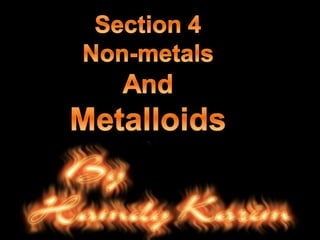
Ch. 3 elements and the periodic table(sec.4)
- 2. Non-metals They are elements that lack most of the properties of metals Physical Properties Chemical Properties • Have lower density. • Most of them are • Powder, stones, reactive. liquids, or gases. • Their atoms usually • Poor conductors of gain or share heat and electricity. electrons during • 10 of 16 non-metals chemical reaction. are gases at room • Can form covalent temperature. compounds with other non-metals.
- 3. Group 18 – The Noble gases He Ne Ar Kr Xe Rn
- 4. Group 18 – The Noble gases Some facts… 1) All of the noble gases have a full outer shell, so they are very Unreactive. 2) They all have low melting and boiling points 3) They exist as single atoms rather then diatomic molecules 3) Helium is lighter than air and is used in balloons and airships (as well as for talking in a silly voice)
- 5. Group 13: Boron Group Aluminum is the most common element from Group 13. Group 13 properties: • group contains one metalloid and five metals • 3 electrons in the outer level • reactive • solids at room temperature
- 6. Group 14: Carbon Group Group 14 properties: • group contains one nonmetal, two metalloids, and two metals • 4 electrons in the outer level • reactivity varies among the elements • solids at room temperature •Example: Diamonds and soft are carbon •Example: Silicon and Germanium make computer chips
- 7. Group 15: Nitrogen Group Group 15 properties: • group contains two nonmetals, two metalloids, and two metals • 5 electrons in the outer level • reactivity varies among the elements • solids at room temperature (except for nitrogen, which is a gas)
- 8. Group 16: Oxygen Group Group 16 properties: • group contains three nonmetals, one metalloids, and one metal • 6 electrons in the outer level • reactive • solids at room temperature (except for oxygen, which is a gas) •Example: Sulfur is the most widely used element in the chemical industry •Example: Oxygen makes up about 20% of the atmosphere and is needed to burn
- 9. Group 7 – The halogens F Cl Br I At
- 10. Group 7 – The Halogens Some facts… reactivity Decreasing 1) Reactivity DECREASES as you go down the group (This is because the electrons are further away from the nucleus and so any extra electrons aren’t attracted as much). 2) They exist as diatomic molecules (so that they both have a Cl Cl full outer shell): 3) Because of this fluorine and chlorine are gases at room temperature and bromine is a water
- 11. 1) Halogen + metal: The halogens – some reactions + - Na + Cl Na Cl Halogen + metal ionic salt 2) non-metal + halogen: H + Cl Cl H Halogen + non-metal covalent molecule
- 12. Uses of the Halogens • Fluorine is put into water supplies to kill harmful bacteria and to help keep teeth healthy. • Chlorine is used in swimming pools to kill bacteria in the water. • Bromine is used in pesticides. Silver bromide is used in photography. • Iodine is an antiseptic on cuts and grazes.
- 13. Metalloids •Metalloids are the elements that border the zigzag line. Atoms of metalloids have about half of a complete set of electrons in their outer energy level. • Metalloids have some properties of metals and some properties of nonmetals. • Metalloids are also called semiconductors.
- 14. How shells fill • The first electron shell can only hold a maximum of 2 electrons. • The second electron shell can hold a maximum of 8 electrons. • The third electron shell can also hold a maximum of 8 electrons. • The fourth electron shell can also hold 8 electrons.
- 15. Electron structure Consider an atom of Potassium: Nucleus Potassium has 19 electrons. These are arranged in shells… The inner shell has __ electrons The next shell has __ electrons The next shell has __ electrons Electron structure The next shell has the remaining __ electron = 2,8,8,1
- 16. First 20 Elements continued • Hydrogen 1 • Helium 2 • Lithium 2,1 • Beryllium 2,2 • Boron 2,3 • Carbon 2,4 • Nitrogen 2,5
- 17. First 20 Elements continued • Oxygen 2,6 • Fluorine 2,7 • Neon 2,8 • Sodium 2,8,1 • Magnesium 2,8,2 • Aluminum 2,8,3 • Silicon 2,8,4
- 18. First 20 Elements continued • Phosphorus 2,8,5 • Sulphur 2,8,6 • Chlorine 2,8,7 • Argon 2,8,8 • Potassium 2,8,8,1 • Calcium 2,8,8,2
